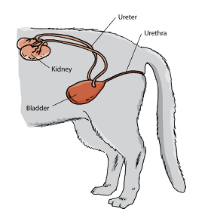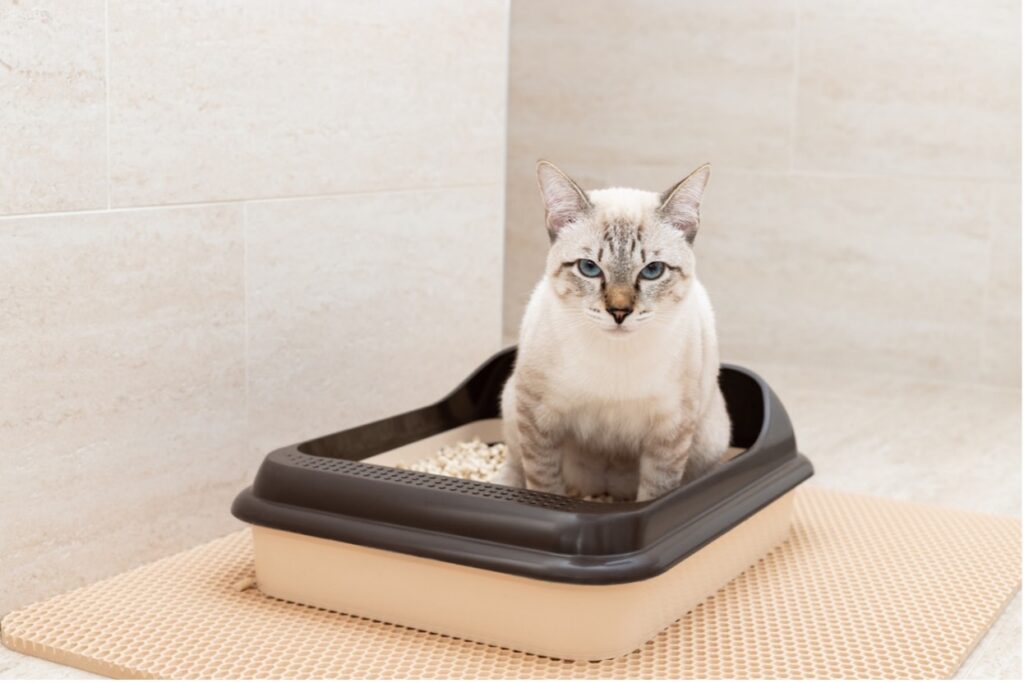Causes, Symptoms, and Treatment with Pine Creek Animal Hospital’s Expertise
As a cat owner, one of the most alarming and distressing health issues you may encounter is a urinary blockage. Urinary blockages can be painful and life-threatening for your feline companion. Understanding the causes, symptoms, prevention measures, and treatment options for this condition is essential for providing the best care for your cat. Here we will cover managing and preventing urinary blockages in cats and how Pine Creek Animal Hospital can provide specialized care, including perineal urethrostomy.
What is Urinary Blockage in Cats?
 |  |
A urinary blockage in cats, medically known as Feline Lower Urinary Tract Disease (FLUTD), refers to an obstruction that prevents normal urine flow from the bladder through the urethra and out of the body. This condition can affect cats of any age, breed, or gender, but we see it more in males due to their narrower urethras.
Causes of a Urinary Blockages
Urethral obstructions can be caused by plugs (a mix of mucus, crystals, and inflammatory cells), stones, blood clots, masses, or congenital defects.
- Crystals and Stones: Crystals and stones can form in the urinary tract, causing blockages. These crystals are often made of minerals like struvite or calcium oxalate.
- Mucus and Blood Clots: Sometimes, mucus or blood clots can obstruct the urethra, making urination difficult for your cat.
- Inflammation: Inflammation of the urinary tract lining can narrow the urethra, leading to blockages.
- Bladder Stones: These are hard, mineralized accumulations that can form in the bladder and cause blockages.
- Tumors: Rarely, tumors in the urinary tract can obstruct urine flow.
Signs and Symptoms
Noticing a urinary blockage in your cat can be challenging for a pet parent, as cats often hide their pain. However, there are several signs and symptoms to watch for:
- Straining to Urinate: Frequent visits to the litter box without producing much urine or visible straining during urination.
- Painful Urination: Your cat may cry or vocalize while urinating.
- Frequent Licking of Genital Area: Cats may excessively groom their genital area to respond to discomfort.
- Blood in Urine: Bloody urine is a common symptom of urinary blockages.
- Change in Urine Behavior: If your cat starts urinating outside the litter box or avoids it altogether, it could be a sign of a problem.
- Lethargy and Vomiting: As the condition progresses, your cat may become lethargic and vomit.
Emergency Treatment is Critical
A cat’s urinary blockage is a serious medical emergency requiring immediate treatment. It is most commonly seen in male cats and can be life-threatening if not addressed promptly. In particular, cats with a blocked urethra may develop acute kidney failure and very high blood potassium concentrations. Life-threatening consequences can occur in as little as 12-24 hours of being unable to urinate. Death from untreated obstruction may occur in as little as 36-48 hours. Here are the steps typically taken when treating a cat with a urinary blockage:
- Seek Veterinary Care Immediately!Contact us immediately or an emergency veterinary clinic right away. This condition can progress rapidly and cause severe complications.
- Diagnosis:Upon arrival at the veterinary clinic, the veterinarian will perform a physical examination and may use diagnostic tests like bloodwork and urinalysis to confirm the blockage and assess the cat’s overall health.
- Stabilization:Cats with urinary blockages often have high levels of toxins and electrolyte imbalances in their bloodstream. The first step is to stabilize the cat’s condition. Stabilizing a cat may involve administering intravenous (IV) fluids to correct dehydration and electrolyte imbalances. We may also give the cat pain relief.
- Relief of the Blockage: The most critical step is to relieve the urinary blockage through one of the following methods:
- Urinary Catheterization: A urinary catheter is gently inserted into the cat’s urethra to remove the blockage. We usually put a cat under sedation or anesthesia for this procedure.
- Surgery: In cases where catheterization is not possible or unsuccessful, surgical intervention may be necessary to remove the blockage. Surgery is more invasive and may require a more extended recovery period.
- Monitoring:After the blockage is relieved, we will monitor the cat closely to observe urine output and continue IV fluids to support kidney function. Depending on the cat’s condition, monitoring may last for a day or longer.
- Medications:Depending on the underlying cause of the blockage (e.g., urinary crystals or stones, urinary tract infection), your veterinarian may prescribe medications such as antibiotics, pain relievers, and special diets to manage the condition and prevent future blockages.
- Dietary and Lifestyle Changes:Your veterinarian may recommend dietary changes to prevent the formation of crystals or stones in the future. We will often prescribe a diet designed to dissolve or prevent the formation of certain types of stones.
- Follow-up Care:It’s crucial to follow your veterinarian’s instructions for post-treatment care, including administering medications, monitoring urine output at home, and attending follow-up appointments.
Pine Creek Animal Hospital’s Expertise
Pine Creek Animal Hospital is dedicated to providing comprehensive care for your beloved pets, including advanced procedures like perineal urethrostomy for cats with recurring urinary blockages. Perineal urethrostomy is a surgical procedure that involves creating a new opening in the urethra to bypass the narrowest part of the urethra, which is often the site of blockages in male cats.
We recommend this procedure in cases where recurrent blockages are a significant concern. The skilled veterinarians at Pine Creek Animal Hospital have the expertise and experience to perform this surgery safely and effectively, improving your cat’s quality of life and reducing the risk of future urinary obstructions.
Preventing Urinary Blockages
Preventing urinary blockages in cats is essential, especially for male cats, as they are more prone to this condition.
- Proper Hydration: Ensure your cat has access to clean, fresh water. Consider using a cat water fountain to encourage drinking.
- High-Quality Diet: Feed your cat a balanced high-quality diet formulated to promote urinary tract health. Consult with your veterinarian at Pine Creek Animal Hospital for appropriate dietary recommendations.
- Regular Veterinary Check-ups: Schedule regular check-ups to catch and address any urinary issues early. We can monitor your cat’s overall health and recommend preventive measures.
- Litter Box Maintenance: Keep the litter box clean and provide your cat with a quiet, stress-free environment. If you have a multi-cat household, have enough litter boxes so cats do not have to compete to use the litter box.
- Stress Reduction: Minimize stressors in your cat’s environment, as stress can contribute to FLUTD. Provide a calm and consistent routine. Consider using pheromone diffusers or collars such as Feliway. Also, there are many cat calming chews products. Catification, popularized by Jackson Galaxy, is another way of reducing stress in a cat.
- Environmental Enrichment: Provide mental and physical stimulation through toys, scratching posts, and interactive play.
Conclusion
Urinary blockages in cats can be distressing and life threatening, but with timely veterinary care, preventive measures, and the expertise of Pine Creek Animal Hospital, you can help your feline friend avoid this painful condition. Always be vigilant for any signs of discomfort or changes in your cat’s urination behavior and contact us if you suspect a urinary blockage. Your proactive care and Pine Creek Animal Hospital’s specialized services can significantly impact your cat’s well-being.
Warm Regards from Your Caring Team at








